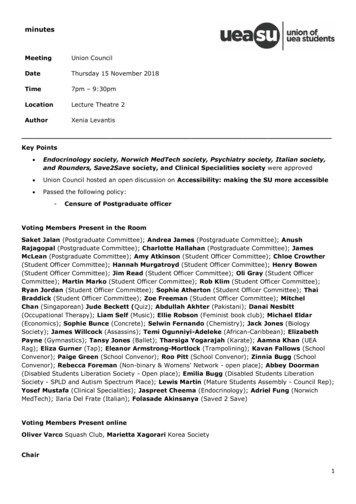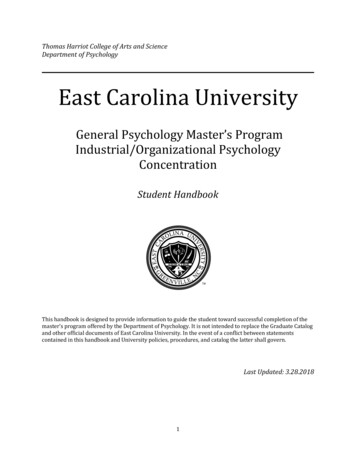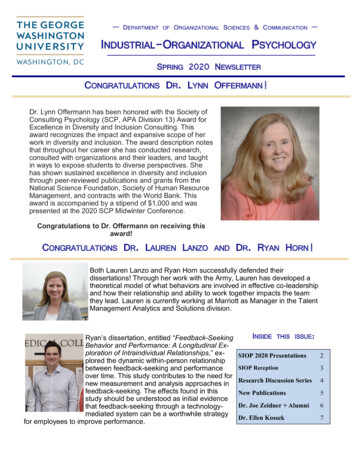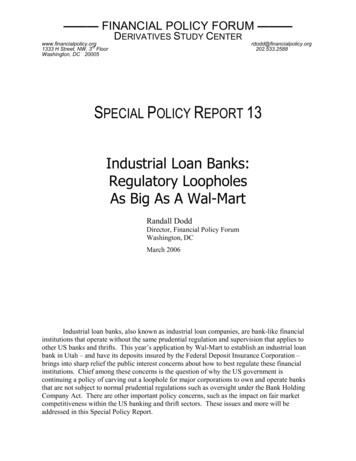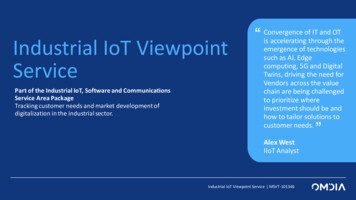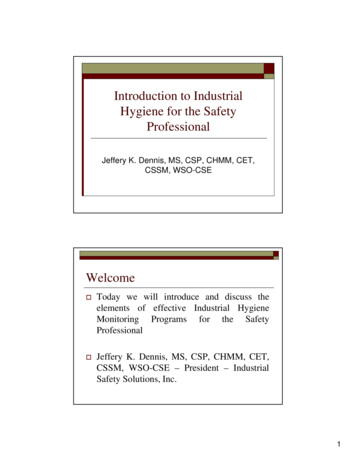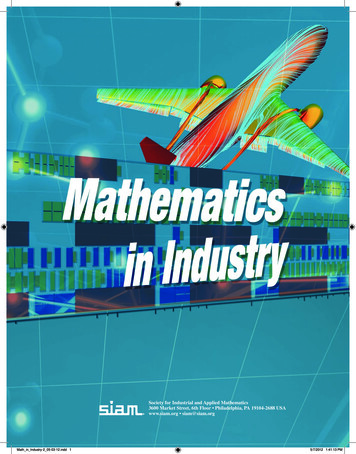
Transcription
Society for Industrial and Applied Mathematics3600 Market Street, 6th Floor Philadelphia, PA 19104-2688 USAwww.siam.org siam@siam.orgMath in Industry-2 05-03-12.indd 15/7/2012 1:41:13 PM
The cover image illustrates the results of a fluid flow calculation over an airplane. For thisdesign, there is little flow separation occurring on the wing except near the wingtips and near theside of the body. In addition, the flowfield streamlines from the nacelle up over the wing showvortex shedding from “chines” which are structures mounted on the nacelles that are specificallydesigned and optimized to shed this vortex. Without them, installing the nacelle forward of thewing as in this design would compromise both the efficiency of the wing as well as its maximumlift capability. See [Konigs 2005]Copyright 2012 by Society for Industrial and Applied Mathematics, Philadelphia, PAISBN 012/report.pdf2Math in Industry-2 05-03-12.indd 2Society for Industrial and Applied MathematicsMath in Industry5/7/2012 1:41:13 PM
Contents12345Introduction. 61.1The SIAM 2011 Mathematics in Industry Study: Background. 61.2Scope and Methodology. 7The Role of Mathematical Sciences in Industry:Trends and Case Studies. 92.1Business Analytics. 92.2Mathematical Finance. 112.3Systems Biology. 122.4Oil Discovery and Extraction. 142.5Manufacturing. 152.6Communications and Transportation. 202.7Modeling Complex Systems. 212.8Computer Systems, Software, and Information Technology. 23Life After the PhD: Results from the MII Survey. 253.1Background and Demographics. 253.2Role of Recent Graduates in Their Companies. 273.3Qualifications and Skill Sets. 28Perspectives on Graduate Education. 304.1PhD Education. 304.2The Professional Master’s Degree. 31Suggestions and Strategies. 335.1Global Strategies. 335.2Graduate Education. 345.3Suggestions for Faculty and Administrators. 365.4Suggestions for Industrial Scientists and Decision Makers. 376Conclusions. 397Acknowledgments. 408References. 41Math in IndustryMath in Industry-2 05-03-12.indd 3Society for Industrial and Applied Mathematics35/7/2012 1:41:13 PM
Executive SummaryIn 1996, the Society for Industrial and Applied Mathematics (SIAM) published the SIAMReport on Mathematics in Industry, which was based on a study supported by grants from theNational Science Foundation and the National Security Administration. That report, and a set ofNSF-funded regional workshops that followed it, helped raise the awareness of mathematiciansin academia about the role of mathematics in industry. The study was widely cited and used tomotivate curricula and programs that focused on industrial and governmental problems. the US economy ismoving from one thatis based on manufacturing to one thatis based on services.This createsemploymentopportunities formathematicians inbusinesses thatprovide consultingservices in the realmsof businessoperations, science,and engineering.Since 1996 there have been many changes in the types and scale of challenges that industryand government are facing. For example, the deciphering of the human genome and theavailability of molecular dynamics simulations are beginning to transform the pharmaceuticalindustry. These changes create new opportunities for graduates with backgrounds in statistics,data mining and simulation. The financial sector has experienced tremendous growth since1996 as an employer of mathematicians. Even though the credit crisis of 2007–8 brought“quants” into some disrepute, companies are still eager to hire graduates who have true insightinto both mathematics and finance. Also, the US economy is moving from one that is basedon manufacturing to one that is based on services. This creates employment opportunitiesfor mathematicians in businesses that provide consulting services in the realms of businessoperations, science, and engineering.In view of these changes, we felt that it was time to update the 1996 report and look at the waymathematical sciences are used in industry today. We also wanted to hear about the experiencesof recent PhD graduates who have chosen to pursue industrial careers. Accordingly, weconducted focus group meetings with industrial scientists, an online survey of recent doctoraldegree recipients, and onsite interviews with 56 senior scientists and managers from 23corporations. In total, we have interviewed or surveyed 145 mathematical and computationalscientists from 14 major industrial sectors.Our most important conclusion is that the mathematical and computational sciences continueto find many applications, both traditional and novel, in industry. Some of these applicationshave very dramatic effects on the bottom line of their companies, often in the tens of millionsof dollars. Other applications may not have an easily measured impact on the bottom line butsimply allow the company to conduct business in a 21st-century data-rich marketplace. Finally,some applications have great value as contributions to science. We want to emphasize thattechnology transfer, including the transfer of mathematical ideas, is not a one-way street; atechnology designed for or by one company often ends up enriching science as a whole.The centerpiece of this report is a set of case studies from a variety of applications, includingbusiness analytics and optimization, manufacturing design and virtual prototyping, quantitativedrug design, financial risk analysis, production planning and supply chain management,and information retrieval and data mining. We intend these case studies to be inspiring andinformative for a wide range of readers: from students wanting to know “What is mathematicsused for, anyway?” to academic departments seeking to understand how to prepare studentsfor non-academic jobs, to mathematicians in industry who would like to explain the valueof mathematical methods to their managers. Often we find that mathematicians in industrydo not feel respected by their colleagues in academia; we hope that the impressive range ofapplications discussed here will convince academic mathematicians that industrial problems canbe difficult, substantive and fascinating.4Math in Industry-2 05-03-12.indd 4Society for Industrial and Applied MathematicsMath in Industry5/7/2012 1:41:13 PM
Mathematical scientists in industry work in a highly interdisciplinary team environment.Their contributions tend to be attributed to the dominant discipline of the team. In 1996 wewrote, “Mathematics is alive and well, but living under different names.” This comment is stillapropos. Unfortunately, it means that a new mathematical approach to an industrial problemmay be difficult to sell to higher management, which might not be prepared to appreciate it.One mathematical scientist and manager whom we interviewed recalled the reaction of a seniormanagement to a suggestion for improving production-line efficiency. The senior managerresponded: “These are the five things I am evaluated on; your idea does not help me in any ofthem.” Because of such attitudes, mathematicians in industry need to develop communication andentrepreneurial skills that may not be as critical in academia. It is not enough to have a good idea;they need to sell it in a language management will understand.This report explores the implications of this interdisciplinary environment for the skills and traitsconsidered essential by employers in industry and government. Our interviewees emphasizedcommunication skills, the ability to work effectively in a team, enthusiasm, self-direction, theability to complete projects, and a sense of the business.In this study we also took a closer look at the technical skills that graduates need, which tendto fall into three overlapping domains: mathematics, computation, and specific applicationdomains. Useful mathematical skills include a broad training in the core of mathematics,statistics, mathematical modeling, and numerical simulation, as well as depth in an appropriatespecialty. Computational skills include, at a minimum, experience in programming in one or morelanguages. Specific requirements, such as C , a fourth-generation language such as MATLAB,or a scripting language such as Python, vary a great deal from company to company and industryto industry. Familiarity with high-performance computing (e.g. parallel computing, large-scaledata mining, and visualization) is becoming more and more of an asset, and in some jobs is arequirement. The choice of an application domain to focus on depends strongly on a graduate’scareer goals and the requirements of his or her potential employer. In general, a student’s levelof knowledge has to be sufficient to understand the language of that domain and bridge the gapbetween theory and practical implementation. mathematicians inindustry needto developcommunication andentrepreneurial skillsthat may not be ascritical in academia.It is not enough tohave a good idea;they need to sell itin a language thatmanagement willunderstand.We conclude the report with a range of suggestions and strategies for enhancing the graduatecurriculum and creating mechanisms for connecting academic, government, and industrialscientists. Some suggestions are intended for students; for the most part they are not new, and yetsome of them are still ignored surprisingly often. For example, we highlight the great importanceof industrial internships or direct work with a mentor from industry during the graduateyears. Other recommendations are directed at academic departments and their industrial orgovernmental partners. Some are straightforward and easily implemented on a local scale, whileothers involve collaboration on an institutional, national, or global scale.Math in IndustryMath in Industry-2 05-03-12.indd 5Society for Industrial and Applied Mathematics55/7/2012 1:41:13 PM
1 IntroductionIndustrial mathematics is a specialty with a curious case of double invisibility. In the academicworld, it is invisible because so few academic mathematicians actively engage in work onindustrial problems. Research in industrial mathematics may not find its way into standardresearch journals, often because the companies where it is conducted do not want it to. (Somecompanies encourage publication and others do not; policies vary widely.) And advisors ofgraduates who go into industry may not keep track of them as closely as they keep track of theirstudents who stay in academia.In 1996,manufacturingaccounted for15.4% of USGDP, while thecombination offinance, insurance,and scientific andtechnical servicesjointly contributed12.5%. By 2010,the order hadreversed, withmanufacturingaccounting for11.7 % and finance,insurance,and scientific andtechnical servicesaccounting for15.9%.In the business world, industrial mathematics is invisible because it is often not called“mathematics.” It is called “analytics,” “modeling,” or simply generic “research.” Credit formathematical advances may go to “information technology” when it should really go to thepeople who use the technology and figure out how to employ it effectively.Of course, for members of the Society for Industrial and Applied Mathematics (SIAM), it willbe no revelation to read that mathematics can make a huge difference for private enterprises and,through them, for society as a whole. But we hope that this report will find its way to peoplewho are not members of SIAM, and who perhaps have not been exposed to the kind of workthat mathematicians in industry do. In particular we hope that this document will be useful, indifferent ways, to students who want to learn about industrial careers; academic mathematicianswho advise and teach those students; university administrators who want to encouragepartnerships with industry; and business managers who want to find out how mathematics canbenefit their companies.For readers who want to know what industrial mathematics is, we recommend skipping therest of this introduction and going straight to part two, where you will learn about eight generalareas of application of the mathematical sciences (broadly defined to include computing andstatistics) to industry. You will also find 18 case studies that illustrate the excitement, vitality, andimportance of mathematics in industry.1.1 The SIAM 2011 Mathematics in Industry Study: BackgroundIn 1996, SIAM published the first SIAM Report on Mathematics in Industry [MII 1996]. Thisreport, and a set of regional workshops that followed its release, helped to clarify the perceptionin academia of the role of mathematics and mathematicians in industry. It provided an overviewof employment opportunities for graduate students, and mathematics departments still refer to itin their career information for students. It has also been cited in subsequent reports by the SmithInstitute, the Organization for Economic Development, and the European Science Foundationon the subject of mathematics in industry, (See [Smith 2004], [OECD 2008], and [ESF 2010].)Anecdotally, the report has been used to motivate the need for (and predict the success of)courses and programs in industrial mathematics and computational science.Many of the recommendations and insights in the 1996 report remain valid today. However, thelandscape of mathematical and computer sciences in industry has changed. Organizations nowcollect orders of magnitude more data than they used to, and face the challenge of extractinguseful information from it. Computing technology has continued to advance rapidly, andcompanies are making more and more aggressive use of high-performance parallel computing.Another important trend is the transition of the US economy from one led by the manufacturingsector to one in which services are more important. In 1996, manufacturing accounted for 15.4%of US GDP, while the combination of finance, insurance, and scientific and technical servicesjointly contributed 12.5%. By 2010, the order had reversed, with manufacturing accounting for11.7% and finance, insurance, and professional and technical services accounting for 15.9%[BEA 2011].6Math in Industry-2 05-03-12.indd 6Society for Industrial and Applied MathematicsMath in Industry5/7/2012 1:41:13 PM
Since 1996 the US government and private foundations have funded several programs that haveaddressed the sharing of knowledge among scientists in academia, government, and industry.For example, the National Science Foundation established its GOALI (Grant Opportunitiesfor Academic Liaison with Industry) program. The US Department of Energy expanded itsComputational Science Graduate Fellowship (CSGF) program and Scientific Discovery throughAdvanced Computing (SciDAC) program. It also launched the Innovative and Novel ComputationalImpact on Theory and Experiment (INCITE) program, which enables businesses to obtain access tosupercomputers and, just as importantly, access to expertise in using them. The Sloan Foundationfunded efforts to develop a Professional Science Master’s (PSM) degree, including degrees inmathematical and computational sciences. Several universities and colleges began building centersand programs in mathematics and computational science with a real-world focus.Finally, the business press has discovered the importance of mathematics, statistics, and computerscience to innovation. See, for example, [Baker 2006], [Baker 2008], [Lohr 2009], [Baldwin2010], [Cohen, N. 2010], [Cohen, P. 2010] and [Hardy 2010]. During the recent mortgage creditcrisis, credit swap models and quantitative models in general received criticism from inside andoutside the business press ([Patterson 2010], [Taleb 2007], and [Triana 2007]). Nevertheless, thisdoes not seem to have dimmed the enthusiasm within the business press. Corporate managementand their shareholders read these articles and books, and we expect that this will create anenvironment in which they will be receptive to the potential value of mathematical and computersciences.In view of all of these changes since 1996, SIAM felt that it was time to update the old report toreflect the new business and economic environment and the new opportunities available. We arealso taking the opportunity to include something that was not provided in the original report, asuite of detailed case studies illustrating the variety of ways in which mathematics is being used inindustry today.1.2 Scope and MethodologyWe began by conducting five small focus groups of industrial scientists. In total, the sessionparticipants included 21 mathematical and computational scientists from nine industrial sectors.The goal was to get a broad overview of the current state of mathematics in industry and to informour questions for the next two phases of the project. We then developed, tested, and administeredan online survey of recent PhDs in mathematics and statistics who took jobs in industry. Ourquestions probed their backgrounds, their group’s tasks, and to what extent their degrees areutilized on the job. We also requested their suggestions for current students. There were 550PhD graduates from June 2004 through July 2007 who took jobs in industry and for whom wecould identify an employer. Of these we were able to find 200 valid e-mail addresses. The surveyreceived a typical online survey response rate of 30 percent.Finally, and separately from the online survey, we conducted in-depth interviews with 56 seniormathematical or computational scientists (of which 21 were senior managers) in industry from 23corporations. In total, through the focus groups, the online survey, and the in-depth interviews, wesolicited the opinions of 145 industrial mathematicians from 14 industrial sectors.There are four significant changes to the scope of this report as compared to the 1996 report.First, we included PhD graduates from statistics departments in our survey. The previous studyincluded such graduates only if they received their degrees from a joint mathematics and statisticsdepartment. Second, we did not survey the immediate supervisors of the graduates, as we did in1996. However, in our in-depth interviews and site visits, we interviewed senior-level managersMath in IndustryMath in Industry-2 05-03-12.indd 7Society for Industrial and Applied Mathematics75/7/2012 1:41:13 PM
and addressed the same questions as we did in 1996. Third, our interviews and site visits didnot deal exclusively with mathematicians and statisticians, but included all mathematical andcomputational scientists no matter what department they received their PhD from. Finally, wedid not interview or survey Master’s graduates for this report. With funding from the SloanFoundation, SIAM undertook a survey of applied mathematics Master’s programs in 2002,[Crowley and Seitelman 2003], and we have not felt it necessary to repeat that effort here.In this report, however, we do discuss the rise and development of the Professional ScienceMasters (PSM) degree. SIAM was involved in the early stages of the PSM movement. TheSIAM Education Committee produced guidelines for a professional Master’s degree in appliedand industrial mathematics, [“SIAM Guidelines” 1998], using the 1996 Mathematics in Industryreport [MII 1996] as a reference.Finally, we will mention that many of the case studies in section 2 of this report were suggestedby or grew out of the onsite interviews. In all cases, the interview information has beensupplemented by publicly available information from published articles and company pressreleases. We include six (out of 18) case studies from companies with which we did not havedirect contact. Those case studies are based entirely on published articles and company pressreleases.8Math in Industry-2 05-03-12.indd 8Society for Industrial and Applied MathematicsMath in Industry5/7/2012 1:41:13 PM
2 Role of MathematicsTrends and Case StudiesIn this section of the report, we give a broad but not exhaustive survey of the businessapplications of mathematics. We hope that the 18 case studies presented below will providesome answers to students who want to know what mathematics is used for “in the real world.”Most of the case studies are applications we heard about on our site visits, supplemented bypublished articles.2.1 Business AnalyticsThe software industry is making a big bet that data-driven decision making is the wave of thefuture. The drive to help companies find meaningful patterns in the data that engulfs them hascreated a fast-growing industry in what is known as “business intelligence” or “analytics”software and services. Major technology companies—IBM, Oracle, SAP, and Microsoft—havecollectively spent more than 25 billion buying up specialist companies in the field.[Lohr, 2011-a]“Business analytics” has become a new catchall phrase that includes well-established fields ofapplied mathematics such as operations research and management science. At the same time,however, the term also has a flavor of something new: the application of the immense databasesthat are becoming more and more readily available to business executives.Mathematical approaches to logistics, warehousing, and facilitylocation have been practiced at least since the 1950s. Earlyresults in optimization by George Dantzig, William Karush,Harold Kuhn, and Albert Tucker were encouraged and utilizedby the US Air Force and the US Office of Naval Research fortheir logistics programs. These optimization techniques, such aslinear programming and its variations, are still highly relevant toindustry today.The new opportunity, both for businesses and for studentshoping to enter industry, lies in the development of algorithmsand techniques to handle large amounts of structured andunstructured data at low cost. Corporations are adopting businessintelligence (i.e., data) and analytics (i.e., quantitative methods)across the enterprise, including such areas as marketing, humanresources, finance, supply chain management, facility location,risk management, and product and process design.Case Study 1: Predictive AnalyticsAutomating decisions in business processes, IBM CorporationIn 2009 and 2010, IBM helped the New York State Division of Taxation and Finance (DTF)install a new predictive analytics system, modeled in part on IBM’s successful chess-playingprogram Deep Blue and its Jeopardy!-playing engine, Watson. The Tax Collection OptimizationSolution (TACOS) collects a variety of data, including actions by the tax bureau (e.g., phonecalls, visits, warrants, levies, and seizure of assets) and taxpayer responses to the actions (e.g.,payments, filing protests, and declaration of bankruptcy). The actions may be subject to certainconstraints, such as limitations on the manpower or departmental budget for a calling center. Themodel also includes dependencies between the actions. TACOS predicts the outcome of variouscollection strategies, such as the timing of phone calls and visits. The mathematical techniqueMath in IndustryMath in Industry-2 05-03-12.indd 9Society for Industrial and Applied Mathematics95/7/2012 1:41:15 PM
used is called a Markov decision process, which associates to each taxpayer a current state andpredicts the likely reward for a given action, given the taxpayer’s state. The output is a plan orstrategy that maximizes the department’s expected return not just from an individual taxpayer, butfrom the entire taxpaying population.In 2009 and 2010, TACOS enabled the DTF to increase its revenue by 83 million (an 8%increase) with no increase in expenses. The results included a 22% increase in the dollarscollected per warrant (or tax lien), an 11% increase in dollars collected per levy (or garnishment),and a 9.3% reduction in the time it took cases to be assigned to a field office [Apte, 2011].Similar methods, though different in detail, could clearly be applied by other businesses in areaslike collections and accounts receivable.Case Study 2: Image Analysis and Data MiningSAIC is a company that develops intelligence, surveillance, and reconnaissance (ISR) systemsfor military applications. These automated systems have been heavily exploited during the war inAfghanistan: in 2009, unmanned aerial vehicles (UAV) captured 24 years of full-motion video,and in 2011 they were expected to capture thirty times that amount.This poses an obvious problem: How can the information in the videos be organized in a usefulway? Clearly the army cannot deploy thousands of soldiers in front of computer screens to watchall of those years of video. Even if they could, humans are fallible and easily fatigued. In hours ofsurveillance video it is easy to miss the one moment when something isn’t right—say, a car thathas previously been associated with bomb deliveries drives up to a particular house.SAIC developed a “metadata” system called AIMES that is designed to alert humans to thepossible needles in the haystack of data. First, AIMES processes the video to compensate for themotion of the UAV—itself an interesting mathematical challenge. Then it searches for objectsin the field of vision and stores them in a searchable database. It also “fuses” other kinds of datawith the video data—for example, if the operators of the UAV say, “Zoom in on that truck!” theprogram knows that the object in the field of view is a truck and it may be of interest. Finally,AIMES is portable enough to be deployed in the field; it requires only a server and two or threemonitors. See [“SAIC AIMES” 2010].While stateside industry may not have quite as many concerns about terrorists or roadsidebombs, audio and video surveillance are very important for the security of factories or otherbuildings. Cameras and microphones can be used for other purposes as well; for example, amicrophone might be able to tell when a machine isn’t working right before human operatorscan. Surveillance devices can also help first responders locate victims of a fire or an accident. See[“SAIC Superhero Hearing” 2010].Case Study 3: Operations ResearchIn 2002, Virginia Concrete, the seventh-largest concrete company in the nation, began usingoptimization software to schedule deliveries for its drivers. The company owns 120 trucks,which had been assigned to 10 concrete plants. A significant constraint is that a cement truckhas roughly two hours to deliver its load before it starts hardening inside the truck. Also, theconstruction business is very unpredictable; typically, 95 percent of a company’s orders will bechanged in the course of a day.10Math in Industry-2 05-03-12.indd 10Society for Industrial and Applied MathematicsMath in Industry5/7/2012 1:41:15 PM
Virginia Concrete brought in mathematicians from George Mason University and DecisiveAnalytics Corporation to develop tools to automate truck dispatching. Among other changes, themathematicians found that the company could improve delivery times significantly by movingaway from the model in which individual trucks were assigned to a “home” plant. Instead, theyrecommended that trucks should be able to go to whichever plant is closest. Also, in overnightplanning it turned out to be useful to include “phantom” trucks, representing orders that werelikely to be canceled. If the order was not canceled, it could be reassigned to a real truck.For testing purposes, the company used the software to make all of the scheduling decisions;however, since the system’s installation, dispatchers have been allowed to override the computer.The system has enabled Virginia Concrete to increase the amount of concrete delivered per driverby 26%. [Cipra 2004]2.2 Mathematical Finance there is likely to be less emphasis on exotic derivatives and more trading will take place onexchanges.In the future, models will have to have realistic dynamics, consistent with observation. Control ofexecution costs will also be critical, and for that, a good understanding of market microstructureand trade data will be essential. [From in
3600 Market Street, 6th Floor Philadelphia, PA 19104-2688 USA www.siam.org siam@siam.org Math_in_Industry-2_05-03-12.indd 1 5/7/2012 1:41:13 PM. Society for Industrial and Applied Mathematics Math in Industry The cover image illustrates the resul



